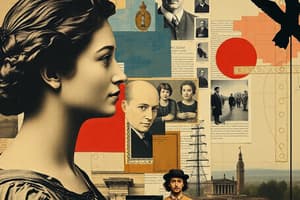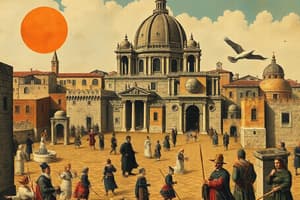Podcast
Questions and Answers
What is the primary significance of Niccolo Machiavelli's work, 'The Prince'?
What is the primary significance of Niccolo Machiavelli's work, 'The Prince'?
- It serves as a critique of Renaissance art.
- It details the history of the Protestant Reformation.
- It lays the foundation for modern political theory. (correct)
- It explores the principles of an ideal society.
What was the primary purpose of Martin Luther's 95 Theses?
What was the primary purpose of Martin Luther's 95 Theses?
- To establish a new form of government in Europe.
- To promote the sale of indulgences.
- To advocate for the unification of Catholicism and Protestantism.
- To challenge the Catholic Church’s practices. (correct)
Which invention is Johannes Gutenberg best known for?
Which invention is Johannes Gutenberg best known for?
- The steam engine.
- The mechanical clock.
- Movable-type printing press. (correct)
- The telescope.
What were the main characteristics of the Renaissance period?
What were the main characteristics of the Renaissance period?
Which English monarch was responsible for the establishment of the Church of England?
Which English monarch was responsible for the establishment of the Church of England?
What does the term 'Triangular Trade' refer to?
What does the term 'Triangular Trade' refer to?
What was one major consequence of the Columbian Exchange?
What was one major consequence of the Columbian Exchange?
Which groups emerged as a result of the Protestant Reformation?
Which groups emerged as a result of the Protestant Reformation?
Which theorist is known for advocating the separation of powers in government?
Which theorist is known for advocating the separation of powers in government?
What event marked the pledge of the Third Estate to not disband until a new French constitution was adopted?
What event marked the pledge of the Third Estate to not disband until a new French constitution was adopted?
Who was the first European to reach India by sea, linking Europe and Asia?
Who was the first European to reach India by sea, linking Europe and Asia?
What was a major cause of the French Revolution related to social status?
What was a major cause of the French Revolution related to social status?
Which philosopher is recognized as the Father of Liberalism?
Which philosopher is recognized as the Father of Liberalism?
What document is associated with the principles of equality and individual rights during the French Revolution?
What document is associated with the principles of equality and individual rights during the French Revolution?
Who led the Reign of Terror during the French Revolution?
Who led the Reign of Terror during the French Revolution?
Which economic theory is associated with the concept of the 'invisible hand'?
Which economic theory is associated with the concept of the 'invisible hand'?
What critical invention was NOT associated with the Industrial Revolution?
What critical invention was NOT associated with the Industrial Revolution?
Which of the following explorers is credited with demonstrating that the New World was not Asia?
Which of the following explorers is credited with demonstrating that the New World was not Asia?
Flashcards
Renaissance
Renaissance
A cultural movement originating in Italy during the 14th century that emphasized classical learning and art.
Reformation
Reformation
A schism within Western Christianity initiated by Martin Luther, John Calvin, and other early Protestants.
Humanism
Humanism
An intellectual movement that celebrated human potential and achievements.
The Prince
The Prince
Signup and view all the flashcards
Utopia
Utopia
Signup and view all the flashcards
Triangular Trade
Triangular Trade
Signup and view all the flashcards
Middle Passage
Middle Passage
Signup and view all the flashcards
Columbian Exchange
Columbian Exchange
Signup and view all the flashcards
Absolutism
Absolutism
Signup and view all the flashcards
Constitutionalism
Constitutionalism
Signup and view all the flashcards
Enlightenment
Enlightenment
Signup and view all the flashcards
First Estate
First Estate
Signup and view all the flashcards
Second Estate
Second Estate
Signup and view all the flashcards
Third Estate
Third Estate
Signup and view all the flashcards
Reign of Terror
Reign of Terror
Signup and view all the flashcards
Tennis Court Oath
Tennis Court Oath
Signup and view all the flashcards
Declaration of the Rights of Man and of the Citizen
Declaration of the Rights of Man and of the Citizen
Signup and view all the flashcards
Invisible Hand
Invisible Hand
Signup and view all the flashcards
Study Notes
Renaissance and Reformation
- Renaissance: A cultural revival in 14th-17th century Italy, emphasizing classical learning.
- Reformation: A religious split within Western Christianity, led by figures like Martin Luther.
- Humanism: An intellectual movement focusing on human potential, rejecting medieval scholasticism.
Key Figures in the Renaissance
- Donatello, Michelangelo, Leonardo da Vinci: Masters of Renaissance art.
- Niccolò Machiavelli: Author of "The Prince," a significant political treatise.
- Thomas More: Author of "Utopia," describing an ideal society.
- Johannes Gutenberg: Inventor of the movable-type printing press, revolutionizing knowledge dissemination.
Post-Reformation Religions
- Protestant denominations: Anabaptists, Lutherans, Calvinists, and Anglicans emerged after the Reformation.
Exploration and Colonization
- Triangular Trade: A trading system between Europe, Africa, and the Americas, involving the slave trade.
- Columbian Exchange: The exchange of plants, animals, culture, diseases, and ideas between the Americas and the Old World.
- Middle Passage: The transatlantic journey of enslaved Africans.
- Explorers: Vasco da Gama (India), Christopher Columbus (Americas), Francisco Pizarro (Inca), and Amerigo Vespucci (New World continent).
- Contributing Nations: Spain, England, Portugal, France, the Netherlands were key in exploration and colonization.
Absolutism, Constitutionalism, and Enlightenment
- Key Philosophers: Thomas Hobbes (absolute sovereignty), John Locke (natural rights), Montesquieu (separation of powers), Jean-Jacques Rousseau (innate goodness, natural law), Adam Smith (classical economics), Mary Wollstonecraft (women's rights), and Voltaire (civil liberties).
- Scientific Revolution/Enlightenment Figures: Ptolemy, Copernicus, Galileo, Kepler, and Newton
The French Revolution
- Estates System: The French social structure prior to the revolution, consisting of clergy, nobility, and commoners.
- Key Events: The fall of the Bastille, Women's March on Versailles, Reign of Terror.
- Reign of Terror: Period of radical repression and bloodshed under the Jacobins, led by Robespierre.
- Tennis Court Oath: A pledge by the Third Estate to create a new constitution.
- Key Causes: Financial crisis, social inequality, political absolutism, and economic hardship.
- The Rights of Man: The Declaration of the Rights of Man and of the Citizen, influenced by Enlightenment ideas and the American Revolution.
- French Monarchs: Louis XVI and Marie Antoinette.
- Post-Revolution Leader: Napoleon Bonaparte.
- Napoleon's Defeat: At the Battle of Waterloo.
Latin American Revolutions
- Social Classes: Social stratification (Peninsulares, Creoles, Mestizos, Native Americans, enslaved Africans) fueled independence movements.
Industrial Revolution
- Key Theories: Adam Smith's "invisible hand", Karl Marx's critique of capitalism.
- Technological Advances: Steam engine, spinning jenny, power loom.
- Causes: Agricultural productivity, population growth, capital, and market access.
- Effects: Urbanization, changes in labor, and significant social/economic transformations.
Studying That Suits You
Use AI to generate personalized quizzes and flashcards to suit your learning preferences.



